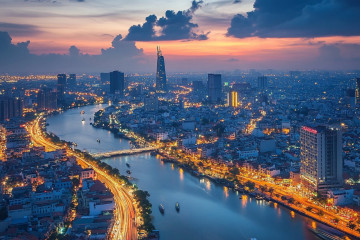Travel can feel overwhelming with chronic pain. Here are some tips to keep your pain in check during your getaway.
Vacations are not necessarily restful. There is always more we want to see, eat, and experience. Just when we think we’re finally content, Instagram sneaks us a new reel that sends us on an urgent new mission. Sometimes, we are so sleep-deprived that we need a vacation when we return from our vacation. But travel can be all the more exhausting with a health condition that causes chronic pain.
I used to be a restless nomad who was quick to pack and slow to miss home. But severe pain, neuralgia, and digestive issues from endometriosis—a pelvic condition that affects the entire body—has made travel more daunting. A heap of symptoms can be tough to bear on a typical Tuesday, let alone when hauled overseas. Every decision I make, from baguettes to beaches, has me considering its consequences as I learn to balance ambition and ability. Like many disabilities, chronic pain is difficult enough to manage in the security of our environment and daily routine. Is it even possible to travel comfortably to a foreign place with an unpredictable condition? Here are 10 practices that help keep pain at bay so you can enjoy your getaway.
1. Check Your Destination’s Accessibility
Preparation helps mitigate the anxiety that comes with unpredictability. Before you go, get familiar with your surroundings. How accessible is your destination? Are there endless stairs or hills to climb? Is there air conditioning to revive you from scorching heat? Locate pharmacies, markets, transportation, and clinics near your accommodation. Consider your room’s amenities: will you have a private bathroom and space to do your exercises? Are check-in and check-out times flexible to help you conserve energy? Look up whether beaches have bathrooms and other services that may be important for managing your condition. To the extent possible, choose a destination or accommodation where you would feel supported if you’re having an off day.
2. Plan for Pain
Booking travel is exciting. It’s tempting to imagine feeling our best and conquering our itinerary with ease, but the reality is that any change in routine can cause a chronic condition to flare, so it’s a good strategy to plan ahead for pain. When possible, select flexible bookings or refundable fares. Make sure you have health insurance. Choose activities that you’d be able to do on a moderate-to-high pain day, not just on your best day. Check in early for your flight to give yourself extra time. Book seats on your train in advance and consider how far you’ll have to walk down the platform or train car to access it. Invest in lightweight luggage with good wheels—your body will thank you.
3. Have All Your Essentials
Packing light is not always possible with an illness or disability, but packing smart is. Picture a bad day: what will you crave? Refill your medications and vitamins before you leave and store them in their original packaging with information on the prescription and dosage, as some medications (like narcotics) might require approval at customs. Pack your favorite clothes and comfortable shoes, and other soothing items you rely on to prevent or recover from flares and fatigue, like heat packs, essential oils, or compression socks. Use packing cubes or airtight bags to squeeze as much as you can in your luggage but keep your must-haves (including your medications) in your carry-on.
4. Know Your Triggers
Self-awareness is key to managing physical, mental, and emotional wellness. We all know our limits (though sometimes we ignore them). Pay attention to your triggers—foods, scents, boat rides on choppy seas, sitting for hours, being on the move all day, not having regular access to a bathroom, late nights, sun exposure… Check in with yourself regularly, even when you think you feel fine, to make sure you are honoring your needs and your body’s distress signals.
5. Pace, Don’t Push
So, you’ve made your itinerary. Great! Now, make a more realistic one. Give yourself breathing room before, during, and after your trip. If you plan excursions, space them out with a low-key day in between so you can linger and recharge. Leave days in your itinerary where you can eliminate the pressure of “doing” and focus on “being.” Consider the timing of your flights or other transport. Will you have to rush to make your connection? Are you leaving yourself enough time to settle back into your rhythm before returning to work? Avoid compromising on sleep (or, at least, not several days in a row).
6. Cultivate Calm
Chronic pain is very real and not “in our head,” but the brain plays a part in how it recognizes, amplifies, and attenuates it. Pain is a nervous system response to a threat, which means stress does play a role in triggering or heightening our pain. It’s a painstaking process to unlearn our fight-or-flight impulses and coax our nervous system out of crisis mode. Mindful travel helps create calm. Slow your pace. Make time to observe your surroundings. Ground yourself with your feet in the sand or deep breaths in a green space. Disconnect from your devices and refrain from documenting. Put your fork down between bites and tune your ear to local dialogue. Pay attention to where you are holding your tension—are your shoulders, jaw, and fists relaxed? Are you holding your breath? Honor your nervous system as you go about your day, so it can lower its guard and unwind.
7. Remember It’s Not All or Nothing
Our brain loves to categorize our options into either-ors and this-or-thats, but there’s an in-between space filled with relief and wonder—we just have to lean into it. To alleviate the emotional distress that comes with chronic pain, gently challenge yourself to think of an in-between option. Stay out late or stay in? Why not go for a bit and duck out early? Eat the food you’ll regret or spend the evening alone? Why not eat earlier on your own but join them for a drink? They’re all biking but you don’t feel up to it? Meet them there with an uber. It’s not always possible to find a workaround, but it’s almost always possible to reframe the black-or-white thinking.
8. Be Honest With Your Travel Companions
Traveling with others—even people we love—can be tricky. All travelers pack their own expectations and personality traits, which can create tension. It might make you feel vulnerable to be open about your condition or wellness needs, but it helps manage expectations. Communicate your preferences and limitations with your travel companions; tell them about your ideal rhythm and budget, activities you can’t do, foods you can’t eat. Agree to split up, meet up, and fill up when needed. Travel becomes even more beautiful when travelers hold space for their individual differences without judgment or resentment.
9. Pack Your Self-Forgiveness
There is certainly grief in not being able, or in not being as able as before. We can’t control how we feel, but we can do our best to recalibrate. Give yourself grace to exist as you are at any given moment, instead of harping on how (or where) you wanted to be. Practice reframing your mindset. Replace “I wasted the day” with “I rested today” or “I chose myself today.” And drop the guilt! Show yourself the inclusivity and empathy you’d want others to show you. A dose of self-forgiveness can feel incredibly refreshing.
10. Ask for Help
We are so conditioned to be independent and productive that we often hesitate to ask for help. Many of us think we don’t deserve accommodations and feel ashamed to ask for them. But a little help can go a long way in improving our day. Ask for pre-boarding if you need extra time, or for a wheelchair if you’re feeling unsteady. Ask for assistance to lift your luggage into the overhead bin, or for a corner where you can stretch during a long flight. It’s okay to ask for a seat on public transportation, even if your illness is invisible to others.
Though it can feel overwhelming to leave the comfort of home when your wellness depends on it, with some careful planning, self-awareness, and communication, your trip can do you a world of good.




1 Comment
dexamethasone tablets uk